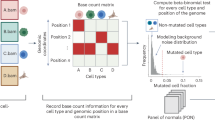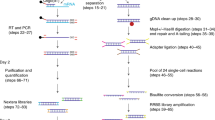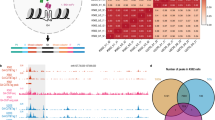Abstract
DNase I hypersensitive sites (DHSs) provide important information on the presence of transcriptional regulatory elements and the state of chromatin in mammalian cells1,2,3. Conventional DNase sequencing (DNase-seq) for genome-wide DHSs profiling is limited by the requirement of millions of cells4,5. Here we report an ultrasensitive strategy, called single-cell DNase sequencing (scDNase-seq) for detection of genome-wide DHSs in single cells. We show that DHS patterns at the single-cell level are highly reproducible among individual cells. Among different single cells, highly expressed gene promoters and enhancers associated with multiple active histone modifications display constitutive DHS whereas chromatin regions with fewer histone modifications exhibit high variation of DHS. Furthermore, the single-cell DHSs predict enhancers that regulate cell-specific gene expression programs and the cell-to-cell variations of DHS are predictive of gene expression. Finally, we apply scDNase-seq to pools of tumour cells and pools of normal cells, dissected from formalin-fixed paraffin-embedded tissue slides from patients with thyroid cancer, and detect thousands of tumour-specific DHSs. Many of these DHSs are associated with promoters and enhancers critically involved in cancer development. Analysis of the DHS sequences uncovers one mutation (chr18: 52417839G>C) in the tumour cells of a patient with follicular thyroid carcinoma, which affects the binding of the tumour suppressor protein p53 and correlates with decreased expression of its target gene TXNL1. In conclusion, scDNase-seq can reliably detect DHSs in single cells, greatly extending the range of applications of DHS analysis both for basic and for translational research, and may provide critical information for personalized medicine.
This is a preview of subscription content, access via your institution
Access options
Subscribe to this journal
Receive 51 print issues and online access
$199.00 per year
only $3.90 per issue
Buy this article
- Purchase on Springer Link
- Instant access to full article PDF
Prices may be subject to local taxes which are calculated during checkout




Similar content being viewed by others
References
Boyle, A. P. et al. High-resolution mapping and characterization of open chromatin across the genome. Cell 132, 311–322 (2008)
Thurman, R. E. et al. The accessible chromatin landscape of the human genome. Nature 489, 75–82 (2012)
Sheffield, N. C. et al. Patterns of regulatory activity across diverse human cell types predict tissue identity, transcription factor binding, and long-range interactions. Genome Res. 23, 777–788 (2013)
Song, L. & Crawford, G. E. DNase-seq: a high-resolution technique for mapping active gene regulatory elements across the genome from mammalian cells. Cold Spring Harb. Protoc. http://dx.doi.org/10.1101/pdb.prot5384 (2010)
John, S. et al. Chromatin accessibility pre-determines glucocorticoid receptor binding patterns. Nature Genet. 43, 264–268 (2011)
Roh, T. Y., Cuddapah, S. & Zhao, K. Active chromatin domains are defined by acetylation islands revealed by genome-wide mapping. Genes Dev. 19, 542–552 (2005)
Litt, M. D., Simpson, M., Gaszner, M., Allis, C. D. & Felsenfeld, G. Correlation between histone lysine methylation and developmental changes at the chicken beta-globin locus. Science 293, 2453–2455 (2001)
Heintzman, N. D. et al. Distinct and predictive chromatin signatures of transcriptional promoters and enhancers in the human genome. Nature Genet. 39, 311–318 (2007)
Creyghton, M. P. et al. Histone H3K27ac separates active from poised enhancers and predicts developmental state. Proc. Natl Acad. Sci. USA 107, 21931–21936 (2010)
Rada-Iglesias, A. et al. A unique chromatin signature uncovers early developmental enhancers in humans. Nature 470, 279–283 (2011)
Wang, Z. et al. Combinatorial patterns of histone acetylations and methylations in the human genome. Nature Genet. 40, 897–903 (2008)
Shalek, A. K. et al. Single-cell RNA-seq reveals dynamic paracrine control of cellular variation. Nature 510, 363–369 (2014)
Sasagawa, Y. et al. Quartz-seq: a highly reproducible and sensitive single-cell RNA sequencing method, reveals non-genetic gene-expression heterogeneity. Genome Biol. 14, R31 (2013)
Lin, C., Garruss, A. S., Luo, Z., Guo, F. & Shilatifard, A. The RNA Pol II elongation factor Ell3 marks enhancers in ES cells and primes future gene activation. Cell 152, 144–156 (2013)
Whyte, W. A. et al. Master transcription factors and mediator establish super-enhancers at key cell identity genes. Cell 153, 307–319 (2013)
Hnisz, D. et al. Super-enhancers in the control of cell identity and disease. Cell 155, 934–947 (2013)
You, J. S. & Jones, P. A. Cancer genetics and epigenetics: two sides of the same coin? Cancer Cell 22, 9–20 (2012)
Chiappetta, G. et al. HMGA2 mRNA expression correlates with the malignant phenotype in human thyroid neoplasias. Eur. J. Cancer 44, 1015–1021 (2008)
Belge, G. et al. Upregulation of HMGA2 in thyroid carcinomas: a novel molecular marker to distinguish between benign and malignant follicular neoplasias. Genes Chromosom. Cancer 47, 56–63 (2008)
Habets, G. G. et al. Identification of an invasion-inducing gene, Tiam-1, that encodes a protein with homology to GDP-GTP exchangers for Rho-like proteins. Cell 77, 537–549 (1994)
Emerling, B. M. et al. Depletion of a putatively druggable class of phosphatidylinositol kinases inhibits growth of p53-null tumors. Cell 155, 844–857 (2013)
Lui, W. O. et al. Expression profiling reveals a distinct transcription signature in follicular thyroid carcinomas with a PAX8-PPARγ fusion oncogene. Oncogene 24, 1467–1476 (2005)
Andersen, K. M. et al. Thioredoxin Txnl1/TRP32 is a redox-active cofactor of the 26 S proteasome. J. Biol. Chem. 284, 15246–15254 (2009)
Gemoll, T. et al. HDAC2 and TXNL1 distinguish aneuploid from diploid colorectal cancers. Cell. Mol. Life Sci. 68, 3261–3274 (2011)
Ni, P. et al. TXNL1 induces apoptosis in cisplatin resistant human gastric cancer cell lines. Curr. Cancer Drug Targets 14, 850–859 (2015)
Buenrostro, J. D. et al. Single-cell chromatin accessibility reveals principles of regulatory variation. Nature 523, 486–490 (2015)
Cusanovich, D. A. et al. Multiplex single-cell profiling of chromatin accessibility by combinatorial cellular indexing. Science 348, 910–914 (2015)
Hu, G. et al. H2A.Z facilitates access of active and repressive complexes to chromatin in embryonic stem cell self-renewal and differentiation. Cell Stem Cell 12, 180–192 (2013)
Hu, G. et al. Expression and regulation of intergenic long noncoding RNAs during T cell development and differentiation. Nature Immunol. 14, 1190–1198 (2013)
Kraushaar, D. C. et al. Genome-wide incorporation dynamics reveal distinct categories of turnover for the histone variant H3.3. Genome Biol. 14, R121 (2013)
Stamatoyannopoulos, J. A. et al. Mouse ENCODE Consortium. An encyclopedia of mouse DNA elements (Mouse ENCODE). Genome Biol. 13, 418 (2012)
Langmead, B. & Salzberg, S. L. Fast gapped-read alignment with Bowtie 2. Nature Methods 9, 357–359 (2012)
Zhang, Y. et al. Model-based analysis of ChIP-seq (MACS). Genome Biol. 9, R137 (2008)
Robinson, M. D., McCarthy, D. J. & Smyth, G. K. edgeR: a Bioconductor package for differential expression analysis of digital gene expression data. Bioinformatics 26, 139–140 (2010)
Yanai, I. et al. Genome-wide midrange transcription profiles reveal expression level relationships in human tissue specification. Bioinformatics 21, 650–659 (2005)
Zang, C. et al. A clustering approach for identification of enriched domains from histone modification ChIP-seq data. Bioinformatics 25, 1952–1958 (2009)
Subramanian, A. et al. Gene set enrichment analysis: a knowledge-based approach for interpreting genome-wide expression profiles. Proc. Natl Acad. Sci. USA 102, 15545–15550 (2005)
McLean, C. Y. et al. GREAT improves functional interpretation of cis-regulatory regions. Nature Biotechnol. 28, 495–501 (2010)
Li, H. et al. 1000 Genome Project Data Processing Subgroup. The Sequence Alignment/Map format and SAMtools. Bioinformatics 25, 2078–2079 (2009)
Acknowledgements
We thank J. Cooper and B. Z. Stanton for reading the manuscript, the National Heart, Lung, and Blood Institute DNA Sequencing Core Facility for sequencing the libraries and the National Heart, Lung, and Blood Institute Flow Cytometry Core facility for sorting the cells. The work was supported by Division of Intramural Research, National Heart, Lung, and Blood Institute (to K.Z.), Intramural Research Program of National Library of Medicine (to T.M.P.) and the Center for Cancer Research of the National Cancer Institute (to D.L.) of the National Institutes of Health.
Author information
Authors and Affiliations
Contributions
K.Z. conceived the project. Q.T., K.C., M.W. and K.Z. performed the experiments. W.J. analysed the data. Y.Z., G.R., B.N., J.S., T.M.P., R.C. and D.L. contributed to the experiments or data analysis. D.L. and K.Z. directed the project. W.J. and K.Z. wrote the manuscript.
Corresponding author
Ethics declarations
Competing interests
The authors declare no competing financial interests.
Extended data figures and tables
Extended Data Figure 1 Scatter plots showing the high correlation of DHSs detected in a small number of cells or single cells.
Each dot represents the tag density of one DHS or more DHSs with the same value. a–c, Correlation of DHSs between ENCODE data and small cell number libraries. d–l, Correlation of DHSs between the five single cells.
Extended Data Figure 2 Venn diagrams showing DHSs detected in single cells significantly overlap with those detected in 1,000 cells or the other single cells.
The total number of DHSs in each library is indicated outside the Venn diagrams. a–d, Overlapping DHSs between single-cell and 1,000-cells data. e–m, Overlapping DHSs between two single cells.
Extended Data Figure 3 Detectability of single-cell DHSs at promoters is positively correlated with gene expression.
a–d, Detection of DHSs around TSSs in each single cell is correlated with higher gene expression. Genes were sorted according to the number of scDNase-seq reads within a ±1 kb region of TSSs and plotted against their expression on the y axis. e–h, scDNase-seq tag density around TSSs in each single cell is positively correlated with gene expression. Genes were sorted into four groups according to their expression levels. Box plots show scDNase-seq tag density around TSSs (y axis). i–l, The proportion of open promoters detected by scDNase-seq in each single cell is positively correlated with gene expression.
Extended Data Figure 4 The DHSs on the promoter of highly expressed genes are more reproducible.
The percentage of overlap between DHSs detected in 1,000 cells and each single cell positively correlates with gene expression. The total number of silent genes, lowly expressed, intermediately expressed and highly expressed genes showing DHSs are indicated outside the Venn diagrams. The numbers in red indicate the percentages of DHSs detected in a single cell that overlapped with the DHSs detected in 1,000 cells.
Extended Data Figure 5 The high variations of distal DHSs and detectability of single-cell DHSs correlate with the number of active histone modifications.
a–d, Distal DHSs showing lower tag density and higher variation than that of proximal DHSs among single cells. The average tag densities of the proximal DHSs among single cells are higher than those of distal DHSs (a). The proximal DHSs showed much higher variation (b) and noise (c) than those of distal DHSs. The fraction of proximal DHSs highly correlates with the number of cells with the DHSs (d). e–h, The histone modification levels (H3K4me3, H3K4me1, H3K9ac and H2A.Z) correlate with the detectability of DHSs in single cells. Histone modification peaks were sorted according to the number of single cells in which they were detected by scDNase-seq. The active histone modification enrichment levels of each group are displayed using box plots. i–l, scDNase-seq density in each NIH3T3 single cell positively correlates with the number of active histone modifications at the DHS. Tag density of each scDNase-seq was sorted according to the number of histone modifications measured on a population of cells using ChIP-seq. The scDNase-seq tag densities for each group are shown by box plots. m, The DHS detectability in single cells is correlated with the tag density of DHS peaks in the 1,000-cells library. The DHSs obtained from the 1,000-cells library were binned to 100 groups on the basis of the tag density (or peak height) (x axis). The y axis indicates the fraction of DHSs detected in single-cell or pooled five single-cell scDNase-seq libraries for each bin.
Extended Data Figure 6 Biological variations contributed to cell-to-cell variation and DHSs detected in single-cell scDNase-seq can predict cell-type-specific enhancers.
a, b, Single-cell chromatin accessibilities and single-cell gene expressions are positively correlated. Average (a) and variation (b) of tag density in single-cell scDNase-seq at gene promoters correlates with that of gene expression level in single cells, respectively. c, d, Biological variations contribute to cell-to-cell variations because the correlation coefficients between technical repeats are significantly higher than those of other pairs of libraries (non-technical repeat pairs). Two NIH3T3 cells were sorted into one tube, which were digested with DNase I and then split to two tubes. Thus each tube contained the amount of DNA that should have been similar to that of one cell. By doing this, the two libraries prepared using the two tubes could be treated as technical repeats. c, Correlation coefficients between technical repeats are higher than those of other pairs of libraries. d, Scatter plot of a pair of technical repeats. e, f, Genes associated with NIH3T3- and ESC-specific DHSs correlate with NIH3T3- and ESC-specific expressed genes, respectively. g, h, Genes associated with NIH3T3- or ESC-specific DHSs are enriched in distinctive GO terms.
Extended Data Figure 7 The scDNase-seq libraries for FFPE tissue slides showing expected patterns.
a, DNA fragments of the scDNase-seq libraries both from cultured cells and from FFPE tissues show periodical cut patterns expected from DNase I digestion of nucleosomal DNA. b, The scDNase-seq reads both from cultured cells and from FFPE tissues are enriched around TSSs. c, The read enrichments around TSSs of FTC 440 normal and FTC 440 tumour are similar.
Extended Data Figure 8 Tumour-specific DHS in FTC-440-enriched GO terms and pathways.
a, b, Normal- and tumour-specific DHSs account for a small fraction of the total DHSs. c, GO biological process terms are significantly enriched in the tumour-specific DHS. d, Pathways are significantly enriched in the tumour-specific DHS. e, Pathways are significantly enriched in the tumour-specific DHS with relaxed threshold. f, Gene sets that represent gene expression signatures of genetic and chemical perturbations are significantly enriched in the tumour-specific DHS.
Extended Data Figure 9 Tumour-specific DHSs are correlated with increased expression in the tumour cells.
a, Genome Browser image showing the increased chromatin accessibility of two tumour-specific DHS regions at the PIP4K2A gene locus (left). The ENCODE H3K4me1 and H3K4me3 peaks are shown at the bottom of the panel. The PIP4K2A mRNA levels in normal and tumour cells, respectively, determined by qRT–PCR and normalized to GAPDH (right). b, Genome Browser image showing the increased chromatin accessibility of the TIAM1 promoter in thyroid tumour cells (left). TIAM1 mRNA levels in normal and tumour cells, respectively, determined by qRT–PCR and normalized to GAPDH (right).
Extended Data Figure 10 Tumour-specific DHSs in each individual are usually unique.
a, The vast majority of DHSs are unique to each individual tumour case. b, Genome Browser image showing the two tumour-specific DHSs at the HMGA2 locus in three patients with FTC. c, The normal cell-specific DHSs are enriched in multiple disease ontologies in PTC 131.
Supplementary information
Supplementary Information
This file contains Supplementary Text with additional references and Supplementary Tables 1-3, 6-8, 11-12 (see separate excel files for tables 4, 5, 9, 10, 13).This file was replaced on 7 December 2015 to amend an incorrect version. (PDF 570 kb)
Supplementary Table 4
Gene ontology terms enrichment in the 3000 genes with the lowest variations among the 5 single 3T3 cells based on DAVID.This file was replaced on 7 December 2015 to amend an incorrect version. (XLS 100 kb)
Supplementary Table 5
Gene ontology terms enrichment in the 3000 genes with the highest variations among the 5 single NIH3T3 cells based on DAVID.This file was replaced on 7 December 2015 to amend an incorrect version. (XLS 63 kb)
Supplementary Table 9
Gene ontology terms enrichment in the 3000 genes with the lowest variations among the 14 ESC single-cell Pico-Seq libraries based on DAVID.This file was replaced on 7 December 2015 to amend an incorrect version. (XLS 111 kb)
Supplementary Table 10
Gene ontology terms enrichment in the 3000 genes with the highest variations among the 14 ESC single-cell Pico-Seq libraries based on DAVID.This file was replaced on 7 December 2015 to amend an incorrect version. (XLS 36 kb)
Supplementary Table 13
List of potential SNVs identified in the tumor cells of FTC #440.This file was replaced on 7 December 2015 to amend an incorrect version. (XLS 50 kb)
Rights and permissions
About this article
Cite this article
Jin, W., Tang, Q., Wan, M. et al. Genome-wide detection of DNase I hypersensitive sites in single cells and FFPE tissue samples. Nature 528, 142–146 (2015). https://doi.org/10.1038/nature15740
Received:
Accepted:
Published:
Issue Date:
DOI: https://doi.org/10.1038/nature15740
This article is cited by
-
Epigenomic analysis of formalin-fixed paraffin-embedded samples by CUT&Tag
Nature Communications (2023)
-
CHEX-seq detects single-cell genomic single-stranded DNA with catalytical potential
Nature Communications (2023)
-
New genetic and epigenetic insights into the chemokine system: the latest discoveries aiding progression toward precision medicine
Cellular & Molecular Immunology (2023)
-
Tcf1–CTCF cooperativity shapes genomic architecture to promote CD8+ T cell homeostasis
Nature Immunology (2022)
-
Opposing functions of circadian protein DBP and atypical E2F family E2F8 in anti-tumor Th9 cell differentiation
Nature Communications (2022)
Comments
By submitting a comment you agree to abide by our Terms and Community Guidelines. If you find something abusive or that does not comply with our terms or guidelines please flag it as inappropriate.



